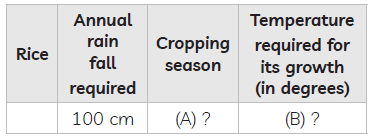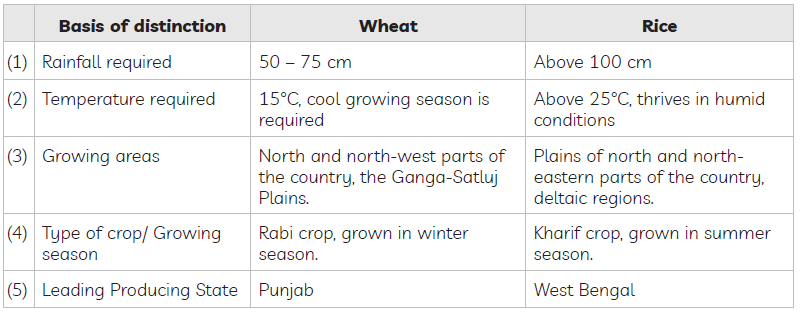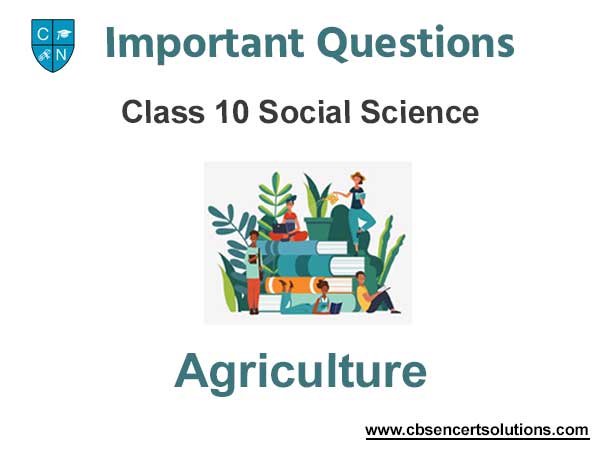Please refer to the Case Study Questions Chapter 4 Agriculture with answers provided for Class 10 Social Science. These solved case study based questions are expected to come in the Class 10 Economics exam in the current academic year. We have provided Case study for Class 10 Social Science for all chapters here. You should practise these solved case studies to get more marks in examinations.
Chapter 4 Agriculture Case Study Questions Class 10 Social Science
1. Read the source given below and answer the following questions:
Globalisation is not a new phenomenon. It was there at the time of colonisation. In the nineteenth century when European traders came to India, at that time too, Indian spices were exported to different countries of the world and farmers of south India were encouraged to grow these crops. Till today it is one of the important items of export from India. During the British period cotton belts of India attracted the British and ultimately cotton was exported to Britain as a raw material for their textile industries. Cotton textile industry in Manchester and Liverpool flourished due to the availability of good quality cotton from India. You have read about the Champaran movement which started in 1917 in Bihar. This was started because farmers of that region were forced to grow indigo on their land because it was necessary for the textile industries which were located in Britain. They were unable to grow foodgrains to sustain their families. Under globalisation, particularly after 1990, the farmers in India have been exposed to new challenges. Despite being an important producer of rice, cotton, rubber, tea, coffee, jute and spices our agricultural products are not able to compete with the developed countries because of the highly subsidised agriculture in those countries. Today, Indian agriculture finds itself at the crossroads. To make agriculture successful and profitable, proper thrust should be given to the improvement of the condition of marginal and small farmers. The green revolution promised much. But today it’s under controversies. It is being alleged that it has caused land degradation due to overuse of chemicals, drying aquifers and vanishing biodiversity. The keyword today is “gene revolution”, which includes genetic engineering.
Answer the following MCQs by choosing the most appropriate option.
(i) What do you understand by ‘gene revolution’?
(a) white revolution
(b) green revolution
(c) genetic engineering
(d) all the above
Answer
C
(ii) What was grown in Champaran?
(a) Indigo
(b) Cotton
(c) Jute
(d) all the above
Answer
B
(iii) In the 19th century which concept was not new?
(a) liberalisation
(b) Democracy
(c) Globalisation
(d) None of the above
Answer
A
(iv) Cotton textile industry in ______________ and Liverpool flourished due to the availability of good quality cotton from India.
(a) Boston
(b) Manchester
(c) California
(d) New York
Answer
B
2. Read the source given below and answer the questions that follows:
The main characteristic of this type of farming is the use of higher doses of modern inputs, e.g. high yielding variety (HYV) seeds, chemical fertilisers, insecticides and pesticides in order to obtain higher productivity. The degree of commercialisation of agriculture varies from one region to another. For example, rice is a commercial crop in Haryana and Punjab, but in Odisha, it is a subsistence crop. Plantation is also a type of commercial farming. In this type of farming, a single crop is grown on a large area. The plantation has an interface of agriculture and industry. Plantations cover large tracts of land, using capital intensive inputs, with the help of migrant labourers. All the produce is used as raw material in respective industries. In India, tea, coffee, rubber, sugarcane, banana, etc., are important plantation crops. Tea in Assam and North Bengal coffee in Karnataka are some of the important plantation crops grown in these states. Since the production is mainly for market, a welldeveloped network of transport and communication connecting the plantation areas, processing industries and markets plays an important role in the development of plantations.
Answer the following MCQs by choosing the most appropriate option.
(i) Which one of the following is the example of plantation agriculture?
(a) Jute
(b) Wheat
(c) Tea
(d) Oilseeds
Answer
C
(ii) Which of the following describes a system of agriculture, where a single crop is grown on a large area?
(a) Shifting agriculture
(b) Plantation agriculture
(c) Horticulture
(d) Intensive agriculture
Answer
B
(iii) Which of the following crops is the main source of jaggery, khandsari and molasses?
(a) Arhar
(b) Coconut
(c) Linseed
(d) Sugarcane
Answer
D
(iv) Which one of the following crops is a beverage crop?
(a) Tea
(b) Cotton
(c) Wheat
(d) Bajra
Answer
A
3. Read the source given below and answer the questions that follows:
You have studied the physical diversities and plurality of cultures in India. These are also reflected in agricultural practices and cropping patterns in the country. Various types of food and fibre crops, vegetables and fruits, spices and condiments, etc. constitute some of the important crops grown in the country. India has three cropping seasons — rabi, kharif and zaid. Rabi crops are sown in winter from October to December and harvested in summer from April to June. Some of the important rabi crops are wheat, barley, peas, gram and mustard. Though, these crops are grown in large parts of India, states from the north and north-western parts such as Punjab, Haryana, Himachal Pradesh, Jammu and Kashmir, Uttarakhand and Uttar Pradesh are important for the production of wheat and other rabi crops. Availability of precipitation during winter months due to the western temperate cyclones helps in the success of these crops. However, the success of the green revolution in Punjab, Haryana, western Uttar Pradesh and parts of Rajasthan has also been an important factor in the growth of the above mentioned rabi crops. Kharif crops are grown with the onset of monsoon in different parts of the country and these are harvested in September-October. Important crops grown during this season are paddy, maize, jowar, bajra, tur (arhar), moong, urad, cotton, jute, groundnut and soyabean. Some of the most important ricegrowing regions are Assam, West Bengal, coastal regions of Odisha, Andhra Pradesh, Telangana, Tamil Nadu, Kerala and Maharashtra, particularly the (Konkan coast) along with Uttar Pradesh and Bihar. Recently, paddy has also become an important crop of Punjab and Haryana. In states like Assam, West Bengal and Odisha, three crops of paddy are grown in between the rabi and the kharif seasons, there is a short season during the summer months known as the Zaid season. Some of the crops produced during ‘zaid’ are watermelon, muskmelon, cucumber, vegetables and fodder crops. Sugarcane takes almost a year to grow.
Answer the following MCQs by choosing the most appropriate option.
(i) Rabi crops are:
(a) sown in winter and harvested in summer
(b) sown during rainy season and harvested in winter
(c) sown in summer and harvested in winter
(d) None of the above
Answer
A
(ii) Match the following
| 1. Kharif | (a) Watermelon |
| 2. Rabi | (b) Aus |
| 3. Zaid | (c) millet |
| 4. paddy crop | (d) oilseeds |
Choose the correct option:
(a) 1–(d), 2–(c), 3–(b), 4–(c)
(b) 1–(b), 2–(c), 3–(d), 4–(a)
(c) 1–(c), 2–(d), 3–(a), 4–(b)
(d) 1–(c), 2–(a), 3–(b), 4–(d)
Answer
B
(iii) Which of the following crops is produced during zaid cropping season?
(a) sugarcane
(b) muskmelon
(c) groundnut
(d) moong
Answer
B
(iv) Which of the following is a kharif crop?
(a) Barley
(b) Peas
(c) Bajra
(d) Mustard
Answer
C
4. Identify the soil with the help of the following features.
* also known as regur soil.
* made of extremely fine i.e. clayey material
* ideal for growing cotton
Answer
Black soil
5. Read the source given below and answer the following questions:
Agriculture has been practised in India for thousands of years. Sustained uses of land without compatible techno-institutional changes have hindered the pace of agricultural development. Inspite of development of sources of irrigation most of the farmers in large parts of the country still depend upon monsoon and natural fertility in order to carry on their agriculture. For a growing population, this poses a serious challenge. Agriculture which provides livelihood for more than 60 per cent of its population, needs some serious technical and institutional reforms. Thus, collectivisation, consolidation of holdings, cooperation and abolition of zamindari, etc. were given priority to bring about institutional reforms in the country after Independence. ‘Land reform’ was the main focus of our First Five Year Plan. The ‘right of inheritance’ had already led to fragmentation of land holdings necessitating consolidation of holdings.
Answer the following MCQs by choosing the most appropriate option.
(i) What do you understand by the term ‘collectivisation’?
(a) Combining land of various farmers and then performing the agricultural activities on collective basis
(b) Combining land of various farmers and then performing the agricultural activities on individual basis
(c) Comparing land of various farmers and then performing the agricultural activities on pocket basis
(d) none of the above
Answer
A
(ii) Which of the following is the most important occupation of the people of India?
(a) Food gathering
(b) Agriculture
(c) Manufacturing
(d) Services
Answer
B
(iii) What was the main objective of First Five Year Plan?
(a) Land forms
(b) Land degradation
(c) Land reforms
(d) all the above
Answer
C
(iv) In spite of development of irrigation , farmers still depend on ____________.
(a) artificial water resources
(b) monsoon
(c) wells
(d) none of the above
Answer
B
Very Short Answer Type Questions
Question. Which crop is known as ‘golden fibre’?
Answer : Jute
Question. Complete the following table with correct information with regard to cultivation of Rice:

Answer : (A) Kharif Cropping Season
(B) 16°C – 27°C.
Question. Write the amount of annual rainfall required for the cultivation of wheat.
Answer : 50-75 cm of rainfall is the amount of rainfall required for the cultivation of wheat.
Question. Write the temperature requirement of the maize crop.
Answer : 21-27 degrees Celsius is the temperature requirement of the maize crop.
Short Answer Type Questions
Question. What are the main features of plantation agriculture? Explain.
Answer : Main features of plantation agriculture are as follows:
(1) Plantation is a type of commercial farming in which a single crop is grown on a large area.
(2) Plantations cover large tracts of land using capital intensive inputs with the help of migrant labourers.
(3) All the produce in this farming is used as raw material in respective industries. Cash crops like tea, coffee, rubber, sugarcane, banana, spices etc. are produced on large scale of sale in the market for which it requires a welldeveloped system of transport and communication.
Question. Describe geographical conditions required for tea cultivation.
Answer : Tea Cultivation:
(1) Tea grows well in tropical and subtropical climates.
(2) Fertile well drained soil.
(3) Warm and moist frost-free climate.
(4) Frequent showers throughout the year.
(5) Intensive labour.
Question. Highlight any three differences between primitive subsistence farming and commercial farming.
Answer : A. Commercial Farming
(1) Use of higher doses of modern inputs like HYV seeds, fertilizers, etc.
(2) Commercialization of agriculture varies from region to another
(3) Plantation is also a type of commercial farming
(4) Use of well-developed network of transport and communication
(5) High productivity for commercial purpose
B. Subsistence Farming
(1) Is practiced on small patches of land
(2) Labour intensive farming
(3) Use of primitive tools
(4) Dependent on Monsoons
(5) Called as ‘Slash and burn’ agriculture.
(6) Low productivity
Question. Wheat and rice farming in India are fairly different from each other. Support the statement.

Answer : The differences between Wheat and Rice Cultivation are explained in the table:
Question. Which crop in India is known as golden fibre? Mention any two geographical conditions that it requires for its growth. What are its uses?
Answer : Jute is called the golden fibre because of its high cash value in the market.
Geographical conditions for its growth are as follows:
(1) Jutes grows well in well-drained fertile soils in the flood plains where soils are renewed every year.
(2) High temperature is required during the time of growth
Uses of Jute are as follows:
(3) Jute is used in making gunny bags, mats, ropes, yarn, carpets and other artifacts.
Question. Describe the technological reforms taken by the Indian Government in the field of agriculture.
Answer : To improve Indian agriculture, the government of India began introducing agricultural and institutional reforms in the 1960s. Some of them have been listed below –
(1) Widespread use of radio and television for providing knowledge to farmers bout new and improved techniques of cultivation and introduction of special weather bulletins.
(2) Crop insurance to protect the farmers’ prouduce against losses by natural and man-made calamities like fire, flood, drought, etc. was introduced.
(3) To ensure easy availability of capital or investment, the Grameen Bank and cooperative societies were established. They provide credit to farmers at very low rates of interest.
(4) Kisan Credit Card (KCC) and Personal Accident Insurance Scheme (PAIS) have been introduced by the government for the benefit of farmers.
(5) Announcement of procurement or remunerative prices, minimum support prices for farmers to reduce exploitation of farmers by middlemen.
Question. Read the sources given below and answer the questions that follows:
Source A: Types Of Farming
This type of farming is still practiced in few pockets of India. It is practiced on small patches of land with the help of primitive tools like hoe, dao and digging sticks, and family community labour. This type of farming depends upon monsoon, natural fertility of the soil and suitability of other environmental conditions to the crops grown.
Source B: Commercial Farming
In India, tea, coffee, rubber, sugarcane, banana, etc., are important plantation crops. Tea in Assam and North Bengal coffee in Karnataka are some of the important plantation crops grown in these states. Since the production is mainly for market, a well- developed network of transport and communication connecting the plantation areas, processing industries and markets plays an important role in the development of plantations.
Source C: Cropping Pattern
In states like Assam, West Bengal and Odisha, three crops of paddy are grown in a year. These are Aus, Aman and Boro. In between the rabi and the kharif seasons, there is a short season during the summer months known as the Zaid season. Some of the crops produced during ‘zaid’are watermelon and muskmelon.
Source A: Types of Farming
(A) Identify the tyoe of Farming through its description in the source?
Source B: Commercial Farming
(B) What do you mean by Plantation Crops?
Source C: Cropping Pattern
(C) Name One Zaid Crop?
Answer : (A) This type of farming is Primitive Subsistence Farming. This type of farming is only used for consumption and subsistence purposes.
(B) A plantation crop is a crop which is cultivated on large scale farms called plantations for export purposes. Plantation farming is a kind of commercial farming and is mainly done for trade. Coffee is a plantation crop.
(C) Another example of Zaid Crop is Cucumber.
Question. State any three characteristics of commercial farming in India.
Answer : The main characteristics of Commercial farming in India are as follows:
(1) Crops are grown on a large scale in large farms or plantations for commercial purposes and for export to other countries.
(2) It is a capital intensive farming and requires high application of modern inputs.
(3) Modern inputs like high yielding variety (HYV)seeds, chemical fertilisers, insecticides and pesticides are used to obtain higher productivity. Irrigation is also used to meet water requirements.
Question. Categorise the following as kharif crops and rabi crops:
(A) Wheat
(B) Maize
(C) Barley
(D) Peas
(E) Bajra
(F) Tur (arhar)
Answer : (A) Wheat – Rabi crop
(B) Maize – Kharif crop
(C) Barley – Rabi crop
(D) Peas – Rabi crop
(E) Bajra – Kharif crop
(F) Tur (arhar) – Kharif crop
Question. ‘India is an agriculturally important country.’ Justify the statement with three arguments.
Answer : Arguments are as follows:
(1) Two-thirds of its population is engaged in agricultural activities.
(2) Agriculture is a primary activity which produces most of the food that we consume.
(3) Besides food grains, it also produces raw material for various industries.
(4) Some agricultural products like tea, coffee, spices etc. are also exported which brings much needed foreign exchange in the country.
Long Answer Type Questions
Question. What steps have been taken by Indian government to modernise agriculture? Explain.
Answer : India is essentially an agricultural country where two-third of its total population are engaged in agricultural activities. Considering, the importance of agriculture in
India, following steps have been taken by the government to modernise it:
(1) Governments has established Indian Council of Agricultural Research.
(2) It has established agricultural universities, veterinary services and animal breeding centres.
(3) It has given priority to research and development in the field of meteorology and weather forecast.
(4) Rural infrastructure has been improved.
(5) Cheap credit facility has been provided to Indian farmers to buy necessary inputs like machines, fertilizers, seeds etc.
Question. Why are maximum Jute textile mills located in the Hugli Basin?
Answer : Location of Jute industries in Hugli basin:
(i) Proximity of jute producing areas.
(ii) Inexpensive water transport.
(iii) Good network of roadways, railways and waterways
(iv) Abundant water for processing raw jute
(v) Cheap labour from West Bengal and adjoining states
(vi) Good banking, insurance and poor facilities in Kolkata.
Question. Compare ‘intensive subsistence farming’ with that of ‘commercial farming’ practiced in India.
Answer : Comparison between ‘Intensive Subsistence farming’ and ‘Commercial farming’:
(1) In Intensive subsistence farming pressure of population on land is high whereas in commercial farming population pressure is low.
(2) In intensive subsistence farming labour intensive farming is used whereas in commercial farming mechanized form of farming is used.
(3) In intensive subsistence farming there is low capital investment whereas in commercial farming high capital investment is seen.
(4) In intensive subsistence farming farmers produce for their own consumption whereas in commercial farming production is mainly for the market.
(5) In intensive subsistence farming processing industries are not associated with farms whereas in commercial farming processing industries are associated with plantations.
(6) In intensive subsistence farming multiple cropping is practiced whereas in commercial farming single cropping is practiced.
(7) In intensive subsistence farming land holdings are small whereas in commercial farming land holdings are large.
Question. Describe any five features of primitive subsistence farming.
Answer : The features of primitive subsistence farming are:
(1) Primitive subsistence farming is a type of farming practice in which the farmer and his family raise crops for home consumption and not trade.
(2) This is practiced with the help of primitive tools like hoe, dao and digging sticks. The farming totally depends on the monsoon and natural fertility of the soil.
(3) It is done on small areas of land and is labour intensive.
(4) It is practiced as a ‘slash and burn’ agriculture. Farmers clear a patch of land and produce crops for their sustenance.
(5) Land productivity is low. No artificial fertilizers are used.
Question. Read the extract given below:
The main characteristic of this type of farming is the use of higher doses of modern inputs, e.g. high yielding variety (HYV) seeds, chemical fertilisers, insecticides and pesticides in order to obtain higher productivity. The degree of commercialisation of agriculture varies from one region to another. For example, rice is a commercial crop in Haryana and Punjab, but in Odisha, it is a subsistence crop.
Plantation is type of commercial farming. In this type of farming, a single crop is grown on a large area. The plantation has an interface of agriculture and industry.
Based on the above comprehension, answer the following questions:
(A) Identify the kind of Farming mentioned in the passage.
(B) What do you mean by a Subsistence Crop?
(C) How can you say that Plantation has an interface of both agriculture and industry?
Answer : (A) The kind of Farming mentioned in the passage is Commercial Farming.
(B) Crop grown for consumption and not for sale purpose is called Subsistence Crop. All food crops are Subsistence crops except if they are grown in surplus. For example: Wheat, Rice etc.
(C) Plantation is an interface of industry and agriculture because in this type of farming, crops are grown using advanced agricultural practices for the purpose of export and trade. The products of Plantation farming are mostly used for selling and not for consumption and hence support various food processing industries. It also provides raw materials to a number of agro industries. This is why Plantation farming is both agriculture and industry mixed into one.
Question. Name the two major fibre crops grown in India. Describe the conditions required for the growth of these two crops with their growing areas.
Answer : Major fibre crops grown in India are:
(1) Cotton
(2) Jute
(3) Hemp
(4) Natural silk
The conditions required for the growth of the following crops are:
(1) Cotton:
(i) Cotton grows well in drier parts of the black cotton soil of the Deccan plateau. It requires high temperature, light rainfall or irrigation.
(ii) It needs 210 frost-free days and bright sunshine for its growth. The leading cotton producing states are Gujarat, Maharashtra, Andhra Pradesh, Punjab, Haryana, Karnataka, Tamil Nadu and Madhya Pradesh.
(2) Jute:
(i) Jute grows well on well-drained fertile soil in flood plains, where soil is renewed every year.
(ii) High temperature is required during the time of growth. Jute is grown in West Bengal, Bihar, Assam, Odisha and Meghalaya.
Question. “The Government of India has introduced various institutional and technological reforms to improve agriculture in the 1980s and 1990s.” Support this statement with examples.
Answer : Reforms made in agriculture sectors are as follows:
(1) Land reforms such as collectivisation, consolidation of land holdings, cooperation and abolition of zamindari system has been given priority.
(2) Provision for crop insurance against drought, flood, cyclone, fire and disease.
(3) Established Grameen banks, cooperative societies and banks for providing loan facilities to the farmers at lower rates of interest.
(4) Government has introduced Kissan Credit Card (KCC), Personal Accident Insurance Scheme (PAIS) for the benefit of the farmers in our country.
(5) Special Weather Bulletins and agricultural programmes such as Krishi Darshan for farmers were introduced on the radio and television.
(6) The government also announces minimum support price, remunerative and procurement prices for importan crops to check the exploitation of farmers by speculators and middlemen.
Question. What are the main characteristic features of intensive subsistence farming? Mention any five of them.
Answer : Main characteristics features of Intensive Subsistence Farming:
(1) This type of farming is practiced in areas of high population pressure on land.
(2) It is labour intensive farming
(3) High doses of biochemical inputs and irrigation are used for obtaining higher production.
(4) Due to the law of inheritance division of land among successive generations has rendered land holding size uneconomical
(5) There is enormous pressure on agriculture land because the farmers continue to take maximum output from the limited land in the absence of alternative source of livelihood.
Question. Name the two major beverage crops grown in India.
Answer : Tea and coffee are the two major beverage crops grown in India.
Tea and coffee are grown in:
(1) Coffee: Coffee grows in areas having with temperature between 15°C and 28°C and rainfall of about 150 cm to 200 cm. The area should have rich, well drained and loamy soil. In India, it grows in hills around Nilgiris, Karnataka, Kerala and Tamil Nadu.
(2) Tea: Tea grows in areas with temperature between 20°C to 30°C and rainfall of about 150 cm to 200 cm. It grows in welldrained soil. In India, it grows in Assam, West Bengal, Tamil Nadu and Kerala.



